20+ Sample Bailment Agreement
-

Bailment Agreement Template
download now -

Sample Bailment Agreement
download now -

Bailment Agreement Example
download now -

Standard Bailment Agreement
download now -

Basic Bailment Agreement
download now -

Customer Bailment Agreement
download now -

Bailment Agreement in PDF
download now -

License Bailment Agreement
download now -
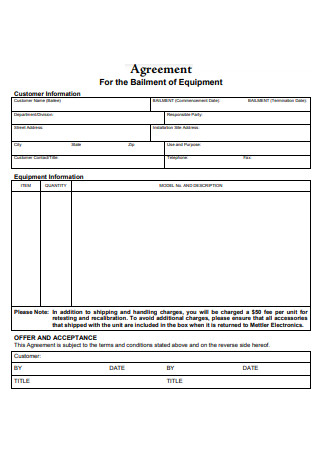
Bailment of Equipment Agreement
download now -

Simple Bailment Agreement
download now -

Bailment Hold Harmless Agreement
download now -
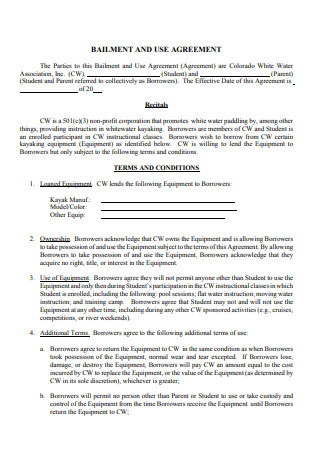
Bailment Agreement Format
download now -

Property Bailment Agreement
download now -

Bailment Agreement For Storage
download now -

Draft Bailment Agreement
download now -
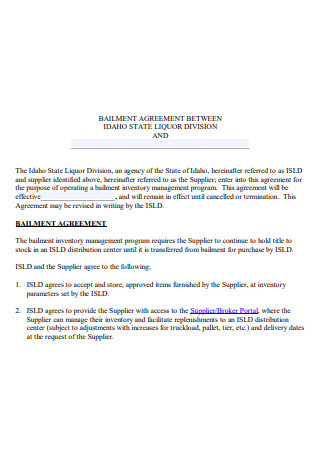
Printable Bailment Agreement
download now -

Bailment and Trading Agreement
download now -
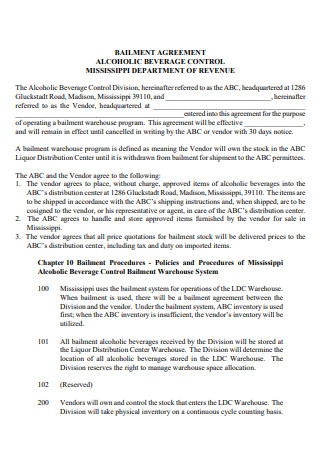
Alcoholic Beverage Control Bailment Agreement
download now -

Portable Range Bailment Agreement
download now -

Formal Bailment Agreement
download now -
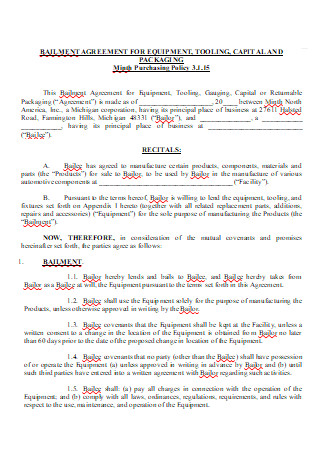
Bailment Agreement in DOC
download now
FREE Bailment Agreement s to Download
20+ Sample Bailment Agreement
What does bailment agreement mean?
Types of Bailment
Key Elements of a Bailment Agreement
Steps in Making a Bailment Agreement
The duties of a Bailee
FAQs
What’s a bailment agreement?
What is the difference between bailment vs loan agreement?
What is the difference between bailment agreement vs consignment?
What does bailment agreement mean?
A bailment contract is an arrangement in which, but does not take ownership of, one person agrees to take the physical custody of the property of another person for security purposes and will, as he understands, be restored later. For example, if, for a few days, you take your watch to a repair shop and leave it there, your watch will be at the store physically, but it will not be owned. It includes an exchange of tangible property, but varies from an agreement on sales, leases and security. Understanding the details can help you decide if you need a bailment arrangement. The bailee is in charge of keeping the item secure, but does not assume ownership, according to the bailment agreement. The bailee is not permitted in its possession to use the property. The arrangement also means that the property can be restored at any moment to the bailor. The main objective of a bailment agreement is to specify the mutual duties of the parties concerned, including why the property was given and the date of return.
Types of Bailment
On the Basis of Reward
Gratuitous Bailment – Gratuitous bailment is a form of bailment when no remuneration is provided to the bailee. Borrow a friend’s automobile, for instance. A free bailee should only be responsible for property damage if the loss is the result of the gross negligence of the bailee. Therefore, in a free bailout, the bailee has a lesser level of care. Free bail is sometimes called naked bailment for the exclusive advantage of.
Non-gratuitous Bailment– In this sort of Bailment, the bailer accomplishes something for bailee in return and the bailee will also pay him back and return his things after the objective has been accomplished. If the bailee suffered losses because of the items under non-free bail, the bailer should pay him compensation. Whether the bailer is fully informed with whether or not it can damage the bailee, it is the bailer’s job to make sure that his products do not create some discomfort.
On the basis of Benefit
Bailment for the exclusive benefit of the bailor – A non-gratuitous bailment for compensation is one which involves some consideration between the bailor and the bailee contrary to gratuitous bailment. The delivery of the items is obviously made in this situation to the mutual benefit of the two parties.
Bailment for the exclusive benefit of bailee – The bailee claims to be very motivated for this scenario. There’s nothing the bailor receives. However, the bailee is paid for owning the items. An understudy takes books for contemplation, for example, from one of its associates. In this case the bailee gets all the benefits since it uses the bailor’s book but the bailor does not get any reward and benefit. The bailee has a significant duty under this kind of bailment since the bailor does not remove any points of interest from this arrangement, he gives the bailee his property for its use. The amount of attention is therefore is quite high.
Bailment for the mutual benefit of bailor and bailee – Both the bailer and the bailee profit from this type of bailment. The two participants come out of the deal they struck, it is like a shared advantage position. For example, if a person provides his or her automobile to fix it, it will benefit the carport owner/distributor as the bailor. In this case, both players benefit from this arrangement, therefore the dancing responsibility is a typical one. Moreover, the bailor’s responsibility is also prevalent.
Key Elements of a Bailment Agreement
Steps in Making a Bailment Agreement
Even though they are not written, state law accepts bailment agreements, but you should nonetheless consider creating one. It will assist to decide the length of the bail and the implications of the breach. The following terms should be included in an enforceable restitution agreement:
Step no. 1: Details of the parties entering the agreement, including names and full addresses
First of all, general information about the individuals participating in the agreement must be identified in all contracts. You may also evaluate risks of your contract and find vital information about the opposing party by knowing who you are negotiating with. If the other party provides one party with any false, faulty or disappointing information in any way, this may amount to a violation of contractual fraud.
Step no. 2: Purpose of the agreement
The objectives of the agreement should be outlined in a Bailment Agreement. This contains both parties’ rights and duties. There should be a description of the agreement and the expected result. If you have hard terms like names of things and tools, define them. To guarantee clarity, this should be as special as feasible.
Step no. 3: Date the agreement takes effect
The day on which the contract enters into force is known as the effective date (or date of contract) which may differ from the date of performance. This date may not precede the day of performance, therefore a contract cannot be signed until all parties have concluded the deal.
Step no. 4: Description of the bailed property
A description of property is a textual part of a property list that explains the property to be sold or rented. Most purchasers now start internet searches for their home. Well made descriptions are thus your finest opportunity to influence buyers and sellers. There are three components in a typical property description:
Step no. 5: Property’s value at the time of the agreement
The property value, although the real price of a property may be more or lower, refers to a fair value in a particular property piece. The valuation of the property takes into account the property’s size and location and any land changes. When purchasing or selling real estate and computing property taxes, people utilize property value.
Step no. 6: Terms of delivery, inspection, and return of the bailed property
There should be statements in the agreement saying the full terms of the delivery of the bailed property. There must also be the statements about how the inspections should be done and also, how is the return of the bailed property going to happen.
Step no. 7: Cost of bailment
It should also be stated how much the amount agreed for the bailment. Lay down all the financial terms in detail so that in case of dispute, the law has got your back and everything is written.
Step no. 8: Penalties for damage or loss of bailed property
From the conditions of a contract between the parties, whether explicit or implicit, the rights, responsibilities and liabilities of a bailor and bailee shall be decided. A bailee is therefore obliged to hold property in a certain manner, or in a certain area, for damage arising from breach of its contract.
Step no. 9: Causes for terminating the agreement
there are instances when there is a dispute between parties, this part tells about the limitations of the contract and defines the causes for termination of the legal bailment agreement.
Step no. 10: Governing law depending on the state
The regulatory law in a contract is the law that applies to everything covered by the contract. For instance, the provision of products is your contract. The law regulating the contract here would apply, including this supply, to the entire deal. Each contract has its own legality. It should be noted depending on which state you’re in.
Step no. 11: Signatures of the parties involved (bailor and bailee)
Signatures are an essential element of a contract. The participants in the contract are so identified. This is so that at the end of the contract the parties are satisfied that the contents of the bailment agreement definition are read, understood and agreed. Any agreement without a signature is considered void.
You can also download different bailment agreement templates provided above.
The duties of a Bailee
Bailee duties are as follows in respect of goods:
FAQs
What’s a bailment agreement?
The term “possession of a good,” which means only possession of the commodities is carried over and not title. The individual who transferred the property is termed ‘bailor,’ and the person who received the property is named ‘bailee.’ The idea that it is a sui generis concept is universally recognized. It has been correctly declared due to its autonomy. The bailment’s aim depends on the specific situation of the transaction. A bailing usually occurs to either benefit the bailor or the bailee, however sometimes both parties receive a benefit. You would gain from the restoration of your property in the first case.
What is the difference between bailment vs loan agreement?
The written agreement between the lender and the lender is a loan arrangement. The borrower undertakes to repay the loan according to the payback calendar (regular payments or a lump sum). This is a very helpful document as a lender, as it makes the borrower pay the debt lawfully. While a bailment agreement is an agreement if, for security or any other purpose, the individual agrees to take the property of another person physically, but does not accept it, as long as he understands it will be restored later. The agreement is based on the agreement.
What is the difference between bailment agreement vs consignment?
A bailment agreement is an agreement if, for security or any other purpose, the individual agrees to take the property of another person physically, but does not accept it, as long as he understands it will be restored later. The agreement is based on the agreement. While a consignment includes the sales by a third party sales company such as consignment stores or online thrift stores of personal products (clothes, furniture, etc.) The owner of the goods pays a share of the sale to the third party for selling purposes.
The main objective of a bailment agreement is to determine both the person giving over his property temporarily and the individual receiving the property, the relationship and the obligations of the parties. This also includes why and when the property is to be surrendered. Make sure to choose a good template to use.
